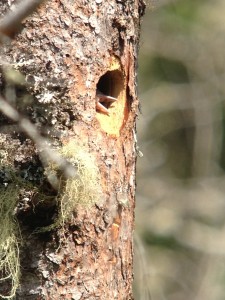
In early May, I found a couple different Black-backed Woodpecker nest sites. The male does all the excavation of the nest hole, which can be in a live tree, dead snag, or even a telephone pole! I have observed nests that ranged from 15 feet above the ground to 65 feet above the ground. One particular nest location this year was in a dead snag about 15 feet above ground. I frequently observed this nest site with clients over the past couple months. It was discovered by many local birders and people frequented the location daily, including folks out walking their dogs.
The male not only does all of the excavation, but he does all of the nighttime incubation and almost all of the fecal sac removal to keep the nest hole clean once the young are born. It was lovely to see how hard both parents worked to constantly feed the very loud nestlings! Black-backed Woodpecker young vocalize non-stop with a constant churring noise coming from the nest hole. You wonder how they survive when they make so much noise. The vocalizations became louder as adults flew in with food – so we would spend time talking and as the young became louder, it would alert us to another feeding session. When the young are big enough, the parents feed them by leaning in the hole. I ended up with lots of photographs of the baby heads sticking out seeking food. I observed two heads, and one client saw three heads at the hole. (They typically have 3 to 4 young.)
I observed a couple of interesting behaviors to note. The parents would sometimes give a softer version of their “kyik” call note and the young would immediately fall silent in the nest hole. It was apparent that it was a signal to be quiet. Also, several times the female Black-backed Woodpecker entered the hole and stuck her head out – sometimes with the bill sticking straight out and sometimes with her head and bill pointed down. This behavior would usually last about 15 to 20 minutes and the young would be completely silent during this period. It appeared to me that she feared a predator and was in a defensive position. Larry Master also noted this behavior when he visited the nest site, and said that he, too, noticed it was the female that was in a defensive position. Larry said that a couple of Common Grackles tried to predate the nest and that the Black-backed Woodpecker adults chased them off. Sean O’Brien once observed a Black-backed Woodpecker in this defensive position inside a nest hole that nailed the face of a Red Squirrel attempting to predate a nest in the same area.
On June 23, 2013, I was with a couple clients and we hiked to the Black-backed Woodpecker nest site. I was a bit concerned as we approached the nest and I did not hear the churring of the young. I set up my scope to view the nest hole, which is out in a swamp area, and I looked into the scope and viewed a Red Squirrel face looking out of the nest hole. I felt sick at the sight. After nearly two months of non-stop work by both parents, they were frantic. The male drummed non-stop on a dead snag next to the nest hole tree, and the female kept flying in to try and peck the squirrel, but she kept flying up as the squirrel would lunge at her. They called – both their short calls and the rattle call. It was an awful scene. We tried different things to get the squirrel to come out of the hole, but it was futile. My clients said they couldn’t stand to watch it any longer so we left. There were no sounds of the young. The young would have fledged in just a few days and they would have continued to be fed by the adults outside the nest. Young in a nest are so helpless, and it was so disturbing to see such a tragic end for these woodpecker babies. Some of the photographs I took over two months are below.
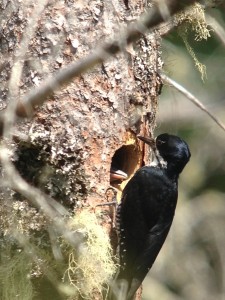
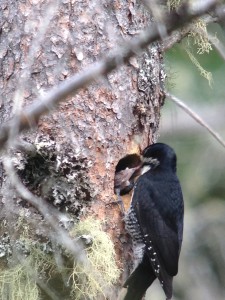
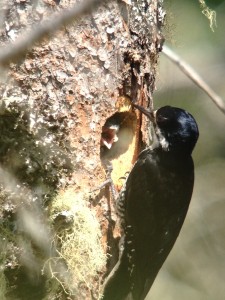
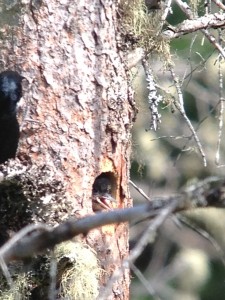
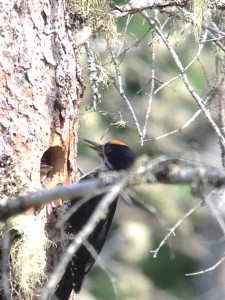
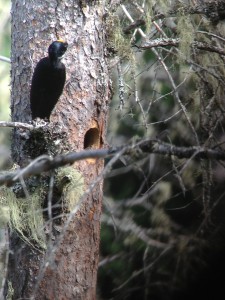
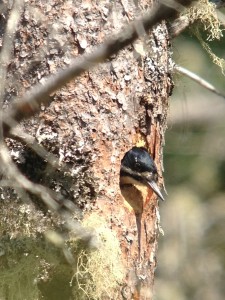
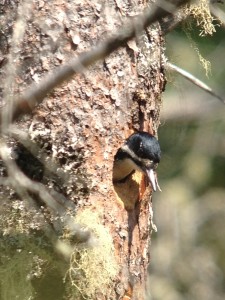
Your write-up was extremely helpful as I have been noticing some woodpecker babies in a similar nest making NON STOP noise for the past several weeks and I was becoming concerned that they were not being fed. Although I figured if they were not being fed, the noise would soon stop :(
Your observation above was helpful and sad! But remember, this is nature and nature is not always pretty.
Thanks again for the helpful information and nice photos!